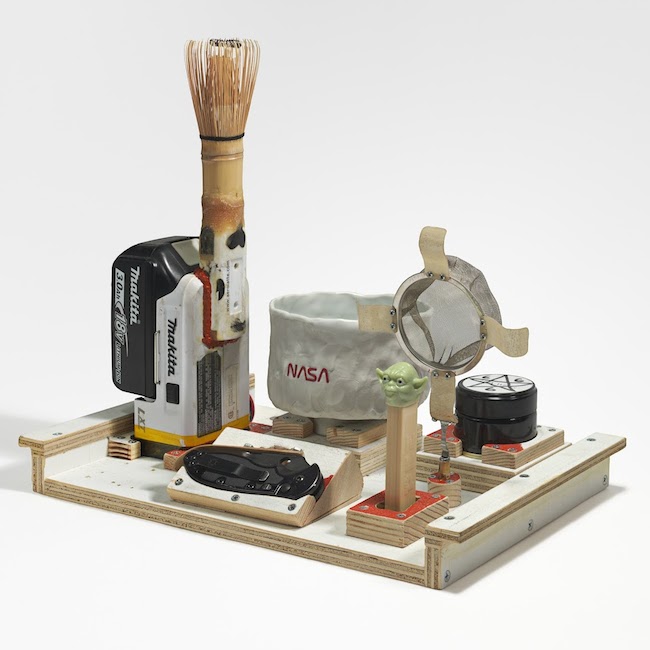QUEENS, NEW YORK — Critics seem to be optimistic with artist Tom Sachs’ spin on the Japanese tea ceremony. The question: how to reimagine an important cultural institution while both being respectful and doing something new?
Above image: Tom Sachs, Chabako (tea utensils), 2015, 12.375 x 14.25 x 9 inches
Writing in The Creators Project Babrielle Bruney states:
“Artist Tom Sachs made his name in the 90s with tongue-in cheek takes on popular culture, like his famous Hello Kitty Nativity. But while his new exhibit, Tea Ceremony (March 23 – July 24), also tackles a cultural institution, this time he’s taking an “irreverent-but-respectful” approach to the Japanese Way of Tea. The show, which will run at New York’s Noguchi Museum from March 23rd to July 24th, 2106, presents a tea house complete with all the tools for the traditional tea ceremony,chanoyu.
“‘Like [museum namesake] Isamu Noguchi, Tom Sachs is a bricoleur of cultures, who marries his equal passions for craft and high technology—NASA being another important practitioner of both—in complex, deeply optimistic, boundary-eroding fantasies’, says Dakin Hart, Senior Curator at the Noguchi Museum.”

Tom Sachs, Chasen (Whisk), 2012
In a warm and expansive review in the New York Times, Ken Johnson notes:
“The tea ceremony isn’t a new theme for Mr. Sachs. In his extravagant installation “Space Program: Mars,” at the Park Avenue Armory in 2012, he included a Japanese tearoom, along with a life-size version of a lunar landing module and other ersatz vehicles and equipment for extraterrestrial exploration. After that, he devoted two years to creating in white clay the perfect chawan, the traditional bowl for tea drinking.
“But while Mr. Sachs shares with Noguchi the impulse to connect the traditional East and the modern West, his work is in conspicuous ways the opposite of Noguchi’s. Mr. Sachs typically cobbles together recognizable objects like sneakers, boomboxes and architectural models from plywood, foam core, glue, tape and myriad sorts of hardware. His comically inelegant works look as if they were created by a manically inventive but not especially skilled handyman in his basement workshop. Noguchi’s sculpture, on the other hand, was invariably suave and formally unified, with a particular predilection for natural forms, textures and materials.

Tom Sachs, Tea House, 2011-2012, mixed media, 122 1/2 x 132 x 202 3/4 inches. Click to see a larger image.
Johnson omits ceramics from his material list, which has been attracting Sachs’ interest for some time. He is the center figure in a group known as Satan Ceramics (note its logo on the container of tea). We reviewed the exhibition at Salon 94 and found it refreshingly seditious but many of our readers did see this aesthetic as the anti-Christ of the kiln. This response was fair seeing as Sachs’ art is brilliant at finding cultural pressure points and pushing them until they hurt. Visual discomfort for those who see his work for the first time is the entry portal. I first came across his work when researching Marcel Duchamp’s Fountain (1917) and Sachs’ witty reinterpretation Chanel Fountain (1998) (made of foamcore, cut shopping bags and thermal adhesive) drew me deeper into his art ever since.

Tom Sachs, Shuki (Sake Set), 2014, 12.25 x 14.25 x 9 inches. Click to see a larger image.
Johnson rounds out his review with a very obvious, but very important question:
“Here is a question one would always ask in single-artist museum, but more so because the artist had practiced the tea ceremony and its adherents can be quite rigid: What would Noguchi have thought about all this?
“Perhaps he’d have been appalled by Mr. Sachs’s ham-handed bricolage. But he might just as well have appreciated Mr. Sachs’ imaginative mix of tradition and DIY futurism. In an exhibition guide essay, the museum’s senior curator Dakin Hart persuasively argues that “the premise of Noguchi’s life and work was the idea that the truest form of respect you can show another culture, traditional or otherwise, is participation: deep engagement, followed by creative adaptation.”

Tom Sachs, Choko (round cup), 2014

“The exhibition guide includes a list of 10 quotations from Noguchi implicitly supporting the idea of Mr. Sachs at the Noguchi Museum. No. 2 says, ‘To be hybrid anticipates the future.’ No. 8 reads: ‘I don’t look at art as something separate and sacrosanct. It’s part of its usefulness.’ And No. 9 advises, ‘Consult NASA.’
“One thing is for sure: If Noguchi were alive today, he and Mr. Sachs would have a lot to talk about.”
Garth Clark is Chief Editor of cfile.daily.
Do you love or loathe this contemporary ceramic art? Let us know in the comments.


Tom Sachs. Photographs courtesy of the museum and the artist.





Add your valued opinion to this post.